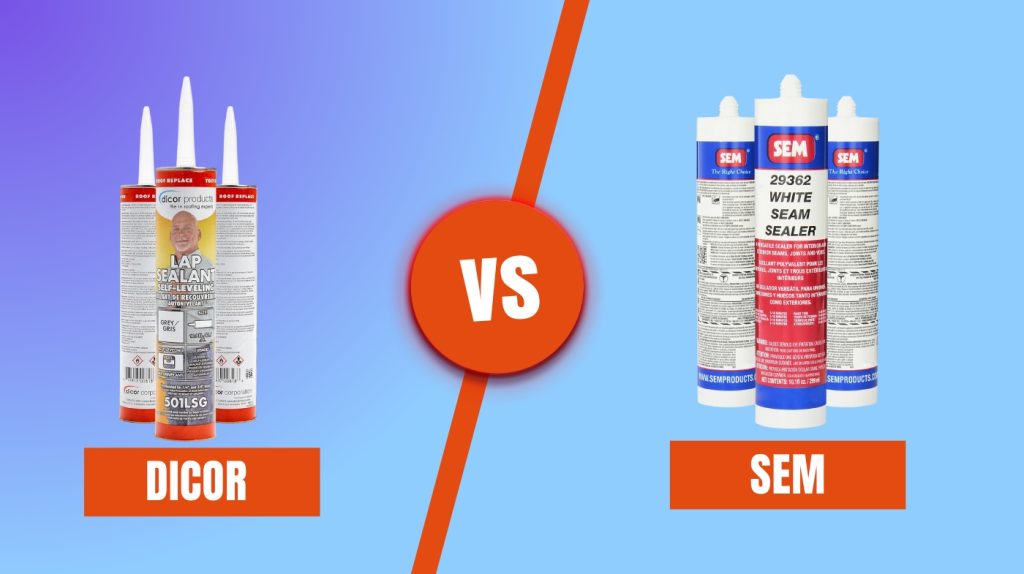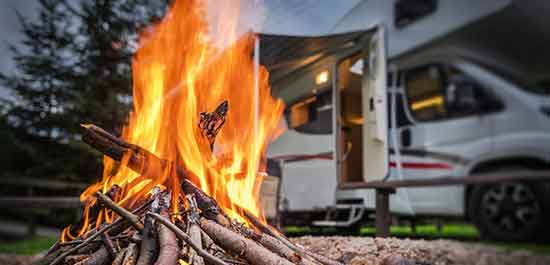Last Updated on February 20, 2025
When comparing Dicor and Sem RV sealants, Dicor stands out with its self-leveling and non-sag options, ensuring reliable seals on various roof materials like EPDM and TPO.
It’s easy to apply, offering long-lasting flexibility and durability against harsh conditions. Sem sealants, recommended by OEMs, provide quick repairs and strong adhesion but lack detailed compatibility specifics.
Both require proper maintenance to avoid leaks. Discover more about their unique features and applications as you explore your options.
- RV ROOFING USE: Lap sealant is sun-ray stabilized to stop decline and discoloration; Plus, it will…
- COLOR: Grey hue for stylish and beautiful RV roof
- EASY TO USE: Self-leveling for smooth application to RV roofing on horizontal surfaces
- SEM Seam Sealer is a versatile single component sealer for sealing interior or exterior seams,…
- It has a flexible, non-sag formula that contains no isocyanates
Key Takeaways
- Dicor RV Sealants are compatible with EPDM, TPO, fiberglass, and aluminum, while SEM’s compatibility details are less clear.
- Dicor offers self-leveling and non-sag options, making application easier for different surfaces compared to SEM’s traditional caulking.
- Dicor sealants maintain flexibility and provide long-lasting water-tight seals, whereas SEM’s durability is less documented.
- Regular inspections and reapplication are recommended for Dicor, ensuring long-term performance, while SEM’s maintenance requirements are not clearly outlined.
Dicor RV Sealants Overview
Dicor RV sealants are essential tools for guaranteeing the longevity and integrity of your recreational vehicle’s roof. They come in two main types: self-leveling and non-sag sealants, each designed for specific applications.
These sealants are compatible with various surfaces, including EPDM, TPO, PVC, and metals, providing versatility for your sealing needs. You’ll find a range of color options—black, white, grey, and tan—to match your RV’s aesthetic.
Additionally, they boast UV stabilization to prevent deterioration and discoloration from sunlight exposure. Dicor’s HAPS-free formula guarantees a safer working environment.
Furthermore, their non-sag formula makes them ideal for use on vertical surfaces, ensuring that the sealant stays in place during application.
Regular inspections and proper application techniques can maximize their effectiveness, keeping your RV roof protected against leaks and environmental damage for years to come.
Moreover, using UV reflective capabilities in sealants further enhances their protective qualities against harmful sun exposure.
Features of Sem RV Sealants
While considering the best sealant for your RV, it’s essential to understand the standout features of SEM RV sealants.
These products are often recommended by OEMs due to their high-quality standards. You can apply SEM sealers directly to metal surfaces, which speeds up repairs considerably.
RV-specific caulking is typically more flexible than traditional caulking, enhancing the overall sealing effectiveness. Additionally, these sealants have high adhesion strength to various materials, ensuring a reliable seal that prevents leaks.
Recommended by OEMs, SEM sealers enhance repair efficiency by applying directly to metal surfaces. Many of these sealants are paintable immediately, allowing you to finish quickly.
They remain flexible and won’t shrink or crack, ensuring long-term effectiveness. With a fast cure time, you enhance both production efficiency and repair speed.
The non-sag formula maintains the integrity of the seal, while color matching reduces post-inspection liability. SEM products also offer versatility, with options for spraying.
Application Process for Dicor Sealants
To guarantee a successful application of Dicor sealants, proper surface preparation is essential. Follow these steps for ideal results:
- Clean the Surface: Remove all dirt, loose paint, rust, oil, and grease.
- Confirm Dryness: The surface must be completely dry before applying the sealant. Proper maintenance is crucial to prevent serious damage from water intrusion.
- Temperature Check: Warm the sealant container to room temperature (16°C – 27°C) in cold weather.
- Select the Right Sealant: Use self-leveling sealants for horizontal surfaces and non-sag sealants for vertical applications.
Apply a bead of about a quarter to three-eighths of an inch wide using a caulking gun.
Durability Comparison: Dicor Vs Sem
When comparing the durability of RV sealants, it’s crucial to examine how each product performs under various conditions.
Dicor stands out with its flexibility over time, maintaining a reliable water-tight seal even as it ages. Unlike SEM RV sealant, which may harden, Dicor resists cracking and brittleness, ensuring long-term effectiveness.
Its self leveling properties allow it to adapt to flat surfaces effectively, enhancing its sealing performance. Its weather resistance allows it to endure UV exposure and temperature fluctuations without significant degradation. While Dicor may require periodic cleaning, it remains easier to touch up compared to silicone-based alternatives.
Though data on SEM’s durability lacks specifics, Dicor’s well-documented performance highlights its resilience against moisture, humidity, and environmental challenges, making it a preferred choice among RV owners seeking lasting protection.
Compatibility With RV Roof Materials
When choosing between Dicor and Sem RV sealants, understanding material compatibility is vital. Dicor excels with a wide range of roofing types, including EPDM, TPO, and fiberglass, ensuring a strong, watertight seal without discoloration.
Additionally, Dicor’s excellent adhesion to aluminum, vinyl, and galvanized metal further enhances its versatility for various roofing materials. Furthermore, sealants with high elongation properties can better withstand temperature fluctuations and maintain strong bonds.
On the other hand, Sem sealant’s specific compatibility details remain less clear, making it important to evaluate your RV’s roof type before making a decision.
Dicor Material Compatibility
Dicor sealants offer excellent compatibility with a variety of RV roofing materials, including EPDM, TPO, fiberglass, and aluminum. This compatibility guarantees a reliable watertight seal essential for protecting your RV from leaks and environmental damage.
Here are key points to take into account:
- EPDM: Specifically designed for RVs, providing flexibility. Regular application of rubber seal conditioners can enhance the longevity of these seals.
- TPO: Works well with fleece-backed TPO; however, newer formulations may show variable compatibility.
- Fiberglass: Bonds effectively, guaranteeing a secure seal without staining. Cleaning of old Dicor sealant is recommended before reapplication to ensure optimal adhesion, as this helps maintain the integrity of the bond.
- Aluminum: Excellent adhesion properties, preventing deterioration and UV damage.
Sem Sealant Limitations
Although Sem sealants may seem like a viable option for RV roof maintenance, their compatibility with various roofing materials presents significant limitations.
There’s limited guidance on Sem sealant’s performance with specific RV materials, which complicates your decision-making. For example, EPDM roofs require non-degrading sealants, while TPO membranes might react poorly with certain products, leading to cosmetic issues. Regular maintenance and inspections can extend roof life, which is crucial when choosing a sealant.
Fiberglass and aluminum roofs also necessitate specialized formulations to avoid damage. If your RV features mixed materials, using a generic sealant can exacerbate compatibility problems.
The RV community often discusses brands like Dicor more, underscoring the uncertainty surrounding Sem sealants. Without detailed compatibility data, you risk damaging your roof and compromising its performance.
Roof Type Considerations
Understanding the compatibility of sealants with various RV roof materials is essential for effective maintenance and long-lasting performance. Choosing the right sealant can prevent future issues and guarantee a secure fit.
Here are key considerations for Dicor sealants:
- EPDM: Excellent compatibility, assuring strong adhesion and flexibility.
- TPO: Use specific formulations to avoid chemical reactions; compatibility varies.
- Fiberglass: Strong adhesion properties, suitable for maintaining integrity.
- PVC: Some Dicor sealants work well with PVC membranes, enhancing versatility. Additionally, Dicor sealants are compatible with various materials such as aluminum, mortar, wood, vinyl, galvanized metal, and concrete.
Always clean and dry surfaces before applying any sealant. Regular inspections and timely repairs are important to prolonging your RV roof’s lifespan and preventing leaks.
User Experience and Feedback
When using Dicor or Sem RV Sealant, you’ll notice distinct differences in application ease and long-term performance.
Many users find Dicor sticky and challenging to smooth, but appreciate its flexibility and moisture protection over time. 100% silicone is recommended for sealing RV vertical seams, which may contribute to the positive feedback surrounding Dicor’s durability.
As you explore user recommendations, consider how these factors influence preferences and overall satisfaction with each sealant.
Application Ease Comparison
While both Dicor and Sem RV sealants are designed for effective application in RV maintenance, user feedback overwhelmingly favors Dicor for its ease of use. Dicor’s self-leveling feature simplifies the process, allowing for smoother application.
Here are some key points about the application ease of Dicor:
- Surface Preparation: Clean surfaces thoroughly to guarantee ideal adhesion.
- Equipment: Use standard caulking tools for application, making it accessible.
- Temperature Considerations: Warm the sealant in cold weather to enhance flow.
- Material Compatibility: Dicor works well with EPDM and TPO roofs, increasing versatility. Additionally, periodic roof inspections can further ensure that the sealants remain effective over time.
In contrast, there’s limited feedback on Sem RV sealants, making it harder to assess their application ease directly.
Long-Term Performance Insights
As RV owners seek reliable solutions for sealing their vehicles, long-term performance insights reveal significant user experiences with Dicor sealant.
Users appreciate its flexibility, which helps prevent cracks and maintains a water-tight seal over time. While adhesion remains effective, some notice it can become unsightly and may shrink, prompting regular inspections.
Importantly, Dicor outperforms traditional caulk by staying flexible, effectively guarding against leaks. However, users often touch up or reapply the sealant to preserve its integrity and appearance. Feedback indicates that while it can age poorly, its moisture barrier properties remain reliable.
Regular maintenance is essential, as many opt for inspections and minor repairs rather than complete removal, ensuring longevity in their RV sealing solutions. Additionally, users often compare Dicor with other products like Eternabond to evaluate their sealing options.
User Recommendations and Preferences
How do users weigh their options when it comes to selecting RV sealants? Many factors influence their preferences, leading to varied recommendations.
Here are some key considerations:
- Ease of Application: Dicor’s self-leveling properties simplify application, ideal for flat surfaces.
- Durability: Sashco’s “Through the Roof” offers superior durability, suitable for extreme conditions, but requires careful handling due to off-gassing. Users have reported that Sashco maintains its performance in extreme temperatures.
- Aesthetic Options: Dicor comes in multiple colors, allowing for a seamless match with RV exteriors.
- Surface Compatibility: Choosing the right sealant type is essential—Dicor for EPDM or TPO, and Sikkaflex for aluminum.
Maintenance Requirements for Each Sealant
To guarantee the longevity and effectiveness of your RV sealants, it’s crucial to understand the maintenance requirements specific to each product.
For both Dicor and Sem RV sealants, inspect the seals at least twice a year, with roof inspections every three months. Dicor typically needs reapplication every few years, depending on usage and weather. Regular maintenance helps prevent seal voids and deterioration, ensuring long-lasting protection.
Before applying new sealant, verify surfaces are clean and free from old material. Use a caulk gun for application and alcohol for cleaning. Pay attention to temperature conditions during application for peak performance.
Always follow manufacturer guidelines, as improper application can lead to seal failure. If you’re unsure about inspections or repairs, consider seeking professional assistance for reliable maintenance.
Environmental Considerations
When considering environmental factors, you’ll find that Dicor sealants offer UV stability, which enhances their longevity and reduces waste. This durability means fewer applications over time, potentially lowering your overall environmental footprint.
Additionally, Dicor’s formulations are designed to minimize harmful effects when used and disposed of properly, making them a responsible choice for your projects. Furthermore, their HAPS-free formula contributes to a cleaner application process, further supporting environmental safety.
UV Stability Comparison
While both Dicor and SEM sealants serve the purpose of protecting RV roofs, Dicor stands out for its superior UV stability, ensuring long-lasting performance under sun exposure.
Here’s how Dicor excels:
- UV Stabilization: Dicor contains UV stabilizers that prevent deterioration and discoloration.
- Material Compatibility: It’s available for various roofing materials like EPDM, TPO, and PVC.
- Longevity: Proper application leads to long-lasting results, reducing the need for frequent reapplications.
- Curing Efficiency: Dicor skins over in about 5 minutes and achieves waterproof status within four hours, enhancing its UV resistance.
Eco-Friendly Formulations
As environmental awareness grows, the demand for eco-friendly formulations in RV sealants like Dicor and SEM has become increasingly important.
Many traditional sealants use polymer-based materials that may contribute to environmental harm. In contrast, options like Ames Blue Max offer biodegradable compositions, reducing ecological impact. Additionally, products like TopCoat® F11® utilize an eco-friendly formula that replaces multiple products, further minimizing environmental harm.
High VOC levels in some products can lead to air pollution and harmful chemical odors, while eco-friendly alternatives often utilize non-toxic ingredients, ensuring safer usage for both you and wildlife.
Additionally, sealants with certifications like GREENGUARD GOLD guarantee compliance with strict environmental standards. While eco-friendly options might come with a higher initial cost, their durability and lower environmental footprint make them a smart choice for responsible RV owners.
Final Considerations for Choosing the Right Sealant
When deciding between Dicor and Sem RV sealants, it’s vital to evaluate your specific needs and the conditions your RV will face.
Consider the materials your RV employs; Dicor excels with EPDM and TPO, while Sashco may react negatively with those materials if not prepared correctly. Choosing the right sealant is crucial to ensure long-lasting repairs and installations.
Durability is important—Sashco offers long-lasting performance in extreme conditions, while Dicor may require reapplication every few years due to shrinkage.
Think about application ease; Dicor is user-friendly, perfect for quick jobs, whereas Sashco demands more skill. Finally, weigh safety aspects; Sashco involves toxic off-gassing, requiring protective gear.
Frequently Asked Questions
How Long Does It Take for Dicor Sealant to Cure Completely?
Dicor sealants take about 30 days to fully cure. Within the first 48 hours, you’ll see roughly 80% of the curing process completed. After just 5 minutes, you’ll notice the sealant skins over, and it becomes waterproof within 4 hours under perfect conditions.
Keep in mind that temperature greatly affects curing time; cooler temperatures can slow it down, so aim for a range between 50 and 70 degrees Fahrenheit for best results.
Can I Paint Over Dicor Sealant After Application?
You can paint over Dicor sealant, but it’s essential to guarantee compatibility first. Not all sealants are designed for painting, so check the specific product guidelines. If compatible, choose a paint that adheres well to sealant materials.
It’s wise to test a small area before full application to confirm adhesion and durability. Always guarantee the sealant is fully cured and clean the surface for the best results.
Is Sem RV Sealant Safe for Pets and Children?
Sem RV Sealant isn’t specifically noted for being pet-safe or non-toxic. While it doesn’t explicitly list harmful toxins, caution is essential. Always guarantee good ventilation during application and keep it away from children and pets until fully cured.
Unlike some alternatives, Sem RV Sealant lacks guarantees regarding harmful VOCs. If pet safety is a priority, consider products like SANI-TRED or ECO-BOND, which prioritize non-toxic formulations suitable for high-traffic environments.
What Temperature Range Is Best for Applying Dicor Sealant?
For best results, you should apply Dicor sealant when temperatures are above 40°F (4°C). Ideally, work within a range of 50°F to 70°F (10°C to 21°C) for full curing, which takes about 30 days under these conditions.
If you’re applying in colder weather, warm the sealant container to room temperature (60°F to 80°F) to facilitate easier application. Always verify the surface is clean and dry before starting your project.
How Do I Remove Old Dicor Sealant Before Reapplication?
Removing old Dicor sealant can feel like unraveling a complex puzzle. Start by evaluating any damage, then gather your tools—plastic scrapers, a heat gun, and rags.
Apply heat to soften the sealant, gently scraping it away. For residue, use turpentine on a rag, followed by cleaning with alcohol. Confirm the surface is debris-free and dry before reapplying new sealant. Always wear protective gear to keep yourself safe throughout the process.
Choosing the Best Sealant: Key Factors to Consider
In choosing between Dicor and Sem RV sealants, it’s essential to evaluate your specific needs and the roof material of your RV. Think of it like picking the right tool for a job; the wrong choice can lead to costly repairs down the line.
Dicor offers excellent durability and compatibility, while Sem provides unique features. Weigh the cost and environmental factors to guarantee you select the sealant that’ll keep your RV watertight for the long haul.
- Creates a secure, secondary seal along the roof’s edges, air vents, vent pipes and screw heads
- Adheres firmly to aluminum, mortar, wood, vinyl, galvanized metal, fiberglass and concrete
- Compatible with EPDM and TPO sheeting
- Use on bare metal or primed surfaces
- Excellent self Leveling properties
- Flows into crevices
Last update on 2025-02-22 / Affiliate links / Images from Amazon Product Advertising API







